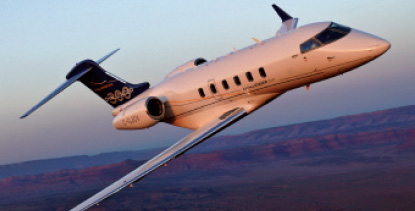 Bombardier’s Challenger 300 has been the most successful of the super-midsize business jets, which combine the spacious cabins of larger business jets with the operating economics of mid-size, turbofan-powered aircraft. Originally called the Continental (perhaps because of its transcontinental range), the Challenger 300 was not based on Bombardier’s Challenger 600 series aircraft, but was designed in the late 1990s as an all-new, twin-engine, winglet-equipped jet capable of flying eight passengers coast-to-coast nonstop.
Bombardier’s Challenger 300 has been the most successful of the super-midsize business jets, which combine the spacious cabins of larger business jets with the operating economics of mid-size, turbofan-powered aircraft. Originally called the Continental (perhaps because of its transcontinental range), the Challenger 300 was not based on Bombardier’s Challenger 600 series aircraft, but was designed in the late 1990s as an all-new, twin-engine, winglet-equipped jet capable of flying eight passengers coast-to-coast nonstop.
Besides its transcontinental range, key features of the Challenger 300 are lower operating costs, higher dispatch reliability, and better long-range cruise speed than legacy mid-size jets; the ability to fly from 5,000-foot-long runways; and a six-foot, one-inch tall cabin that has a flat floor and allows inflight access to the 106-cubic-foot aft baggage compartment. The standard interior has eight seats, arranged in a double-club configuration, although some operators have replaced two of the seats with an optional three-place divan to create a nine-passenger interior.
The Challenger 300 cockpit features the Rockwell Collins Pro Line 21 avionics suite, with four 12-inch-tall by 10-inch-wide flat-panel liquid crystal displays. The aircraft’s two Honeywell HTF7000 powerplants include dual-channel, full authority digital engine controls; advanced engine conditioning/fault reporting tools; and an on-condition maintenance program. The cabin features Lufthansa Technik’s Nice (network integrated cabin equipment) system, which combines cabin management, communications, and entertainment control into a single touch-screen system at each seat location.
Formally launched in June 1999 at the Paris Air Show, the Challenger 300 made its inaugural flight in August 2001. Following certification in mid-2003, the first customer aircraft was delivered in early 2004 to Flexjet, Bombardier’s fractional ownership subsidiary, which had ordered a total of 25 of the aircraft. Other fleet operators include XOJET, the California-based charter company, and NetJets, which has ordered 75 Challenger 300s for delivery beginning in 2014.
Bombardier has made numerous improvements to the Challenger 300 since it entered service, with the most recent being an avionics upgrade that will enable operators to have the same capabilities as buyers of the new Challenger 350, which will be outfitted with the Pro Line 21 Advanced system when it enters service in 2014. Pro Line 21 Advanced retrofits of in-service Challenger 300s are to be accomplished via service bulletins beginning this year. The new avionics suite, which will include Rockwell Collins’ MultiScan weather radar and a synthetic vision system, will enable use of advanced approach procedures, including localizer performance with vertical guidance (LPV) and required navigation performance (RNP).
Some 400 Canadair Challenger 300s have been delivered since 2004. According to the Vref Aircraft Value Reference, an early model Challenger 300 can cost as little as $10.75 million, while the average asking price for a late-model 300 is approximately $19 million.
Robert A. Searles is an aviation writer and editor.
SPEC SHEET
Bombardier Challenger 300
Engines | Two Honeywell HTF7000 turbofans, 6,826 lbs thrust each
Seats | 8-9 passengers
Max takeoff weight | 38,850 lbs
Long-range cruise speed: 458 kt
Takeoff distance | 4,810 ft
Landing distance | 2,600 ft
Range (with IFR reserves) | 3,065 nm
Wingspan | 63 ft 10 in
Length | 68 ft 7 in
Height | 20 ft 4 in


